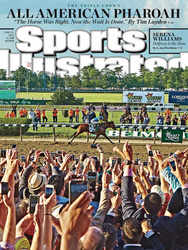
Feat of Clay
Not even a mean case of the flu could derail Serena Williams at the French Open. So, the question: How can she not win the Grand Slam?
IT WAS ONE of those news stories that at once makes Paris so easy to adore and so easy to mock. The city was buzzing last week with the announcement that the 45 tons of "love locks" adorning the Pont des Arts bridge over the river Seine were being removed. The locks, it was explained, had become so heavy that they were a threat to the structural integrity of the bridge. This touched off a round of low-grade protest, Internet outrage and complaints about the local government.
Meanwhile, a few kilometers downriver at Roland Garros, an honorary Parisienne was applying an enormous padlock on her place in tennis, both current and historical. It wasn't simply that Serena Williams won the French Open singles title for the third time last Saturday. Or that she did so while conspicuously sick, seldom summoning her best tennis. Or that she elevated herself further atop the sport, the fall to second place steeper than ever.
It was that she emerged as a good bet to win tennis's Ultimate Bracket Challenge, the Grand Slam. "Put it this way," says 18-time major singles champ Martina Navratilova. "I would be more surprised if she didn't do it than if she did."
Flip forward a few pages in this magazine and you can read about horse racing's Triple Crown. But for now, consider tennis's comparably rare Quadruple Crown—winning the Australian Open, French Open, Wimbledon and U.S. Open in the same year. Here's some perspective on the degree of difficulty: No male player has pulled off the Grand Slam since Rod Laver in 1969 and no female since Steffi Graf in 1988. And before Serena's feat last weekend, no player had even won the first two legs in more than a decade.
It's with good reason. Winning the Slam means mastering four surfaces on three continents over the course of nine months. One off day? One encounter with a hot (tennis locution: zoning) opponent? One encounter with an ill-timed pathogen or an order of bad sushi? Kablooey.
Plus, there's the often vexing French Open, an event filled with so many variables—from the weather to the condition of the courts—that the famed red clay has often doubled as quicksand for the top players.
The reputation of Roland Garros: It's the country in miniature, a rolling festival of charm and stylish elegance and quaint touches. This is a marketing triumph. Now here's the reality: The tournament is an exercise in Parisian chaos, more like a crowded Metro ride than a leisurely barge trip. The tennis itself is—literally—dirty work, a pounding away on a gritty, granular surface that demands patience and exertion. There's a huge variance in the clay itself. Sometimes it plays as fast as a hard court; yet on damp days it can feel like you're playing tennis in a mud pit better suited for monster trucks. The absence of lights, and therefore night sessions, complicates the playing schedule, especially on days with rain delays.
Still, Serena handled the clay just fine. While it's not her preferred surface, blunting as it is to her power, she manages well and has improved her movement through the years. She also negotiated the man-made challenges.
Serena was less successful, however, in handling a mean case of the flu. When she wasn't hacking up a lung on the court, she was playing a level of tennis far from her best. In five of her seven matches she dropped a set. Her triumph was two parts history, one part histrionics. Never one to struggle to access emotion, she didn't hide her symptoms. She sometimes staggered woozily around the court and spent changeovers swaddled in iced towels. "I was literally in my bed shaking," she said.
No matter. Even at a compromised level, she is still able to beat the vast majority of her opponents. In the semifinals she was trailing Switzerland's No. 24--ranked Timea Bacsinszky 4--6, 2--3 before reeling off the last 10 games of the match. In the final she lost the second set to Czech lefthander Lucie Safarova, ranked No. 61, before steadying and closing out her 20th career major. "I always say if I'm losing, I'm going out swinging," she said. "Once I decide that, I start playing my game. And when I'm playing my game, it's difficult for me to lose."
For the 127 other players in the field, there is always the chance of advancement and upward mobility. For Serena, the best she can hope for is a kind of stasis. If she loses? It's an upset. If she wins? Well, she is simply acting in accordance with her ranking. She is fond of quoting the line from her friend, 12-time Grand Slam tournament champion Billie Jean King, "Pressure is a privilege."
For a while there, it looked as if she was going to have company. The winner of this year's Australian Open, Novak Djokovic, arrived in Paris with only two losses in 2015 and as the favorite to win the men's title. Djokovic ended up in the same arrondissement of the draw as nine-time French Open winner Rafael Nadal. Their quarterfinal match was breathlessly deemed the Mayweather-Pacquiao of tennis. Conventional wisdom suggested that whoever won would take the title.
But like last month's fight in Vegas, the match never approached classic status. Mostly because Djokovic simply wouldn't permit it. He deployed classic military tactics, established territory (in this case, pinning Nadal back in the court, closer to the back signage than to the baseline), neutralized Nadal's strength (the serve and the forehand up-the-line) and was aggressively on the attack (45 winners for Djokovic, just 16 for Nadal). By the end Djokovic had broken Nadal's serve and spirit in equal measure and deposed the King of Clay 7--5, 6--3, 6--1.
Next Djokovic outlasted third-ranked Andy Murray in a five-set semifinal that spanned two days (see: lack of lights) and was a match away from winning the title for the first time. Then came Switzerland's Stan Wawrinka. Having spent most of his career obscured by Roger Federer, Wawrinka announced himself in bold and caps lock on Sunday. Bludgeoning the ball off both wings—and unfurling a ravishing one-handed backhand that should be arriving at the Louvre any day now—Wawrinka smote 60 winners, this against the best defensive player, perhaps, in the sport's history. As the match tightened, Wawrinka played more offensively. He was rewarded for his courage, winning 4--6, 6--4, 6--3, 6--4. "I played the match of my life," Wawrinka, 30, said in joyous summary. Like that, Djokovic's once-robust 2015 Grand Slam campaign was stopped after one leg.
The loss throws Williams's feat—and the very real prospect of her winning two more major titles this year—into sharp relief. By now, only the most stubborn in the sport's ecosystem fail to recognize Serena as the GOAT.
In the players' lounge last weekend Oracene Price, the materfamilias, tried to take in the measure of Serena's performance in Paris. Asked what she made of it all, Mom smiled and paused for a good ten seconds. "Really want to know what I think?"
Oui, oui.
"I've thought about it and thought about it," she says. "Here's the truth. Here's her truth...."
The reporter leans in, ready to hang on every word of this gnomic pronouncement.
"Even more than Serena hates to lose," says Oracene, "she really, really likes to win."
Peewee Partners
21
Extra Mustard
25
SI Edge
See World
26
Faces in the Crowd
28
Dan Patrick
Nick Saban
30
The Big Board
Patrick Reed
34
The Case for
Playing College Ball
38
GO FIGURE
2
Innings thrown in his major league debut last Friday by A's pitcher Pat Venditte, who became just the second player in modern major league history to pitch righthanded and lefthanded in the same game. The first was Greg Harris, a 15-year veteran who hurled from both sides once in 1995 for the Expos. Venditte allowed one hit and no walks to the Red Sox.
30
Seconds that a men's college basketball team will now have to shoot the ball. The shot clock had been 35 seconds since 1993--94, but last season Division I teams averaged 67.74 points per game, the third fewest since 1952--53.
85
Score carded by Tiger Woods on Saturday in the third round of the Memorial, the worst performance of his professional career. Woods, who has won the event five times, finished the tournament 14 over, last among the 71 players who made the cut.
0-4
Record for the USMNT against the Netherlands before the Americans beat the Dutch 4--3 on Friday in Amsterdam. The U.S. trailed 3--2 with two minutes to go in regulation of the friendly before Danny Williams tied the score in the 88th minute and Bobby Wood won it in the 90th.
PHOTO
CLIVE BRUNSKILL/GETTY IMAGES (WILLIAMS)
Within Reach Williams's 20th major singles title left her two away from Steffi Graf's Grand Slam record.
TWO PHOTOS
CHARLES KRUPA/AP (VENDITTE, TOP)
PHOTO
JIM ROGASH/GETTY IMAGES (VENDITTE)
PHOTO
DARRON CUMMINGS/AP (WOODS)
PHOTO
KAY INT VEEN/EPA/GETTY IMAGES (USMNT)
TWO PHOTOS
CARLOS M. SAAVEDRA FOR SPORTS ILLUSTRATED
No. 1 Stunner Wawrinka (with trophy) used his killer backhand to overpower Djokovic for the second time in a Grand Slam final.

